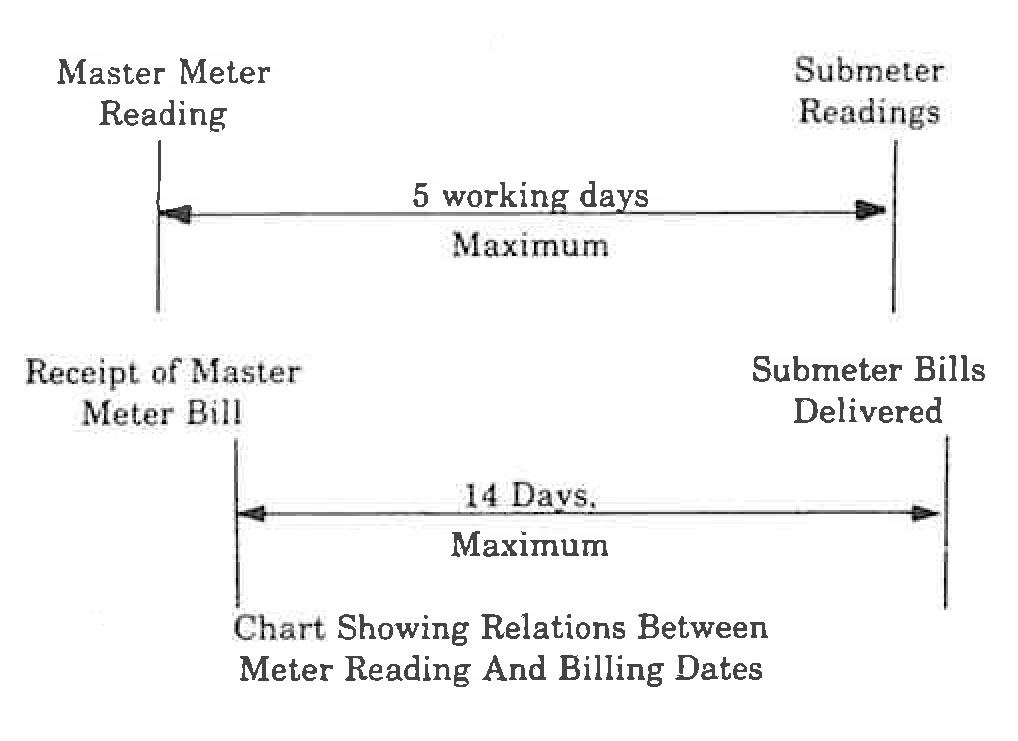.05 Bills, Bill Forms, and Payments.
A. Amount Billed to Occupant. The amount billed to any occupant shall be for only the quantity consumed by the unit, as recorded on the unit's submeter. Energy used in common areas and common facilities may not be billed to any occupant.
B. Calculation of Bills.
(1) The occupants' bills shall be calculated as follows: After receipt of the bill from the utility, electric supplier, or gas supplier, the owner shall divide the total net bill by the total number of kilowatt-hours or cubic feet as shown on the bill, to determine an average unit cost. This average unit cost shall be multiplied by each occupant's kilowatt-hour or cubic feet consumption to obtain the occupant's monthly bill.
(2) The total master meter net bill on which the owner shall calculate the average unit cost shall include:
(a) Customer, energy, commodity, and demand charges by the utility, electric supplier, or gas supplier;
(b) State and local taxes and surcharges by the utility, electric supplier, or gas supplier; and
(c) Environmental surcharge by the utility, electric supplier, or gas supplier.
(3) The total master meter net bill on which the owner shall calculate the average unit cost shall exclude:
(a) Late payment charge, if any;
(b) Any connection charge;
(c) Any charge for a bad check; and
(d) Service charges.
C. Unit of Measurement. The unit of measurement of the occupant's consumption shall be the kilowatt-hour (kWh) for electricity and cubic feet for gas.).
D. Bill Information. The occupant's bill shall show:
(1) The bill date (the date the bill was prepared);
(2) The name of the occupant and the number, or other identification, of the unit;
(3) The dates and readings of the submeter at the beginning and at the end of the billing period;
(4) The amount of kilowatt-hours for electricity or cubic feet of gas billed in the billing period;
(5) The average unit cost used to compute the bill;
(6) The amount due for electricity or gas, the service charge by the owner, if any, the balance forward, and the total amount due;
(7) The name and address of the firm rendering the occupant's bill and the name and address where payment can be made;
(8) The name, address, and telephone number of the party which may be contacted in case of a dispute; and
(9) A statement to the effect that the bill is from the owner.
E. Estimated Bills.
(1) Estimated bills may not be rendered unless the submeter has been tampered with, is out of order, or access to it cannot be obtained, and in this case the bill shall be distinctly marked "estimated".
(2) The estimate shall be based on consumption for a similar billing period when available, and if not available, on the preceding billing period.
(3) The subsequent bill based on actual submeter reading shall show the total period between actual readings and shall indicate credit for the preceding estimate.
F. Mailing or Rendering of Bills.
(1) The owner shall render electric or gas bills to the occupants not later than 14 days after the owner receives the master meter bill from the utility.
(2) The submeters shall be read by the owner within 5 working days of the date the utility reads the master meter.
(3) Bills are due and payable upon receipt by the occupant and become past due if not paid within 20 days from the date of mailing or rendering.
G. Relationships Between Meter Reading and Billing Dates. The following chart illustrates the relations between the meter reading and billing dates specified by this chapter:

H. Service Charge. The owner may impose a service charge not to exceed $1 per unit per month to offset the administrative costs of billing.
